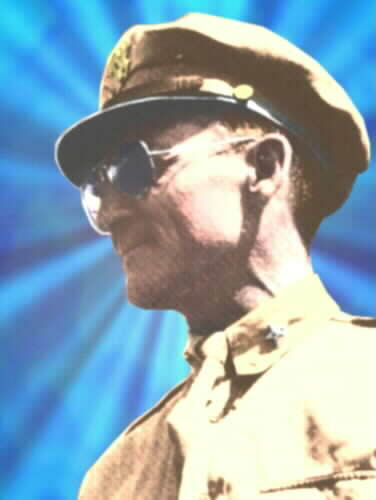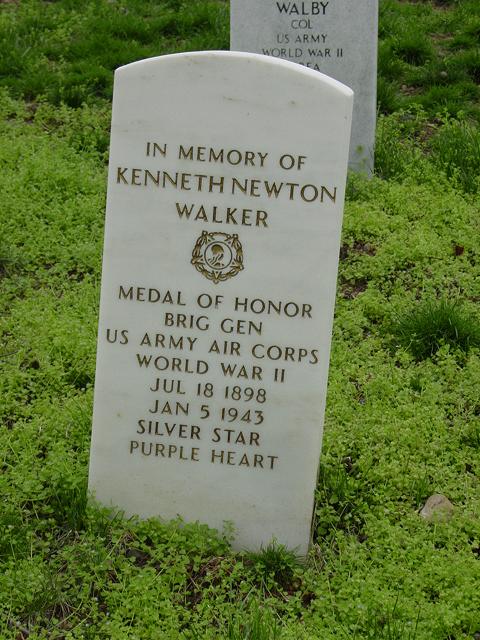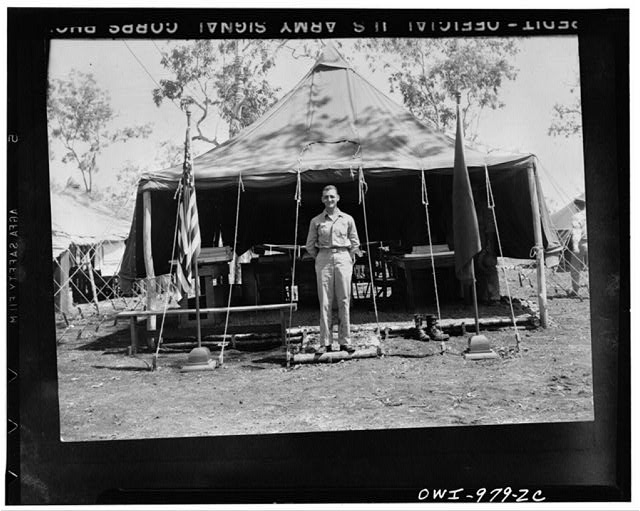Kenneth N. Walker
- Brigadier General, U.S. Army Air Forces
- Service # 0-012510
- Headquarters, V Bomber Command
- Entered the Service from: Colorado
- Died: 12-Dec-45
- Missing in Action or Buried at Sea
- Tablets of the Missing at Manila American Cemetery
- Manila, Philippines
- Awards: Medal of Honor, Silver Star, Legion of Merit, Purple Heart
WALKER, KENNETH N. (Air Mission)
Rank and organization: Brigadier General, U.S. Army Air Corps
Commander of V Bomber Command
Place and date: Rabaul, New Britain, 5 January 1943
Entered service at. Colorado
Birth: Cerrillos, New Mexico
General Orders 13, 11 March 1943
Citation:
For conspicuous leadership above and beyond the call of duty involving personal valor and intrepidity at an extreme hazard to life. As commander of the 5th Bomber Command during the period from 5 September 1942, to 5 January 1943, Brigadier General Walker repeatedly accompanied his units on bombing missions deep into enemy-held territory. From the lessons personally gained under combat conditions, he developed a highly efficient technique for bombing when opposed by enemy fighter airplanes and by antiaircraft fire. On 5 January 1943, in the face of extremely heavy antiaircraft fire and determined opposition by enemy fighters, he led an effective daylight bombing attack against shipping in the harbor at Rabaul, New Britain, which resulted in direct hits on 9 enemy vessels. During this action his airplane was disabled and forced down by the attack of an overwhelming number of enemy fighters.
Courtesy of the United States Air Force Press Service:
6 December 2001
One of America’s airpower pioneers is being memorialized in a December 7 ceremony at Arlington National Cemetery, nearly 59 years after his death in World War II.
Brigadier General Kenneth N. Walker, a co-author of the air campaign strategy used to defeat Germany in World War II, received the Medal of Honor for his actions during a fatal B-17 Flying Fortress mission over the Japanese stronghold of Rabaul, New Britain, on January 5, 1943.
“There was no public memorial to (my father) in the United States where the family could gather,” said Walker’s son, Douglas.
Because his body was not recovered, no plans were made to erect a headstone at Arlington until this year. Walker’s name has been linked to two Air Force facilities, the former Walker Air Force Base, near Roswell, New Mexico; and Walker Hall, home of the College of Aerospace Doctrine Research and Education, at Maxwell Air Force Base, Alabama.
As a bombardment instructor for the Air Corps Tactical School at Maxwell Field, Alabama, Walker coined what became the “creed of the bomber.” It was his belief that airpower offered a revolutionary means to pressure an enemy into capitulation without first defeating opposing ground forces. Stating in lectures that a “well-planned, well-organized and well-flown air force attack will constitute an offensive that cannot be stopped,” he formed a doctrine followed for years to come by such Air Force generals as Curtis LeMay.
While at ACTS, Walker also participated in a study on the accuracy of low-altitude bombing. He discovered that, while targeting was more accurate at low altitude, damage was reduced because of ricochets and other factors. Walker learned that delayed-fused bombs and bombs dropped from higher altitude caused more damage. Subsequent tests justified his idea of a new high-altitude daylight precision bombing doctrine.
In 1934, Walker and four other ATCS instructors were invited to testify on the military aspects of aviation before the President’s Commission on Federal Aviation (the Howell Commission). Though he feared his career would be jeopardized, Walker and his colleagues presented arguments in support of a “separate air organization,” no longer subordinate to other military branches. Ultimately Walker and those who testified with him became general officers.
With war on the horizon, President Franklin Roosevelt asked for an estimate of the overall production requirements needed to defeat potential enemies. Within the air arm of the U.S. Army, that project fell to newly created Air War Plans Division — of which Walker served as Deputy Chief. Within nine days, Walker and three other officers created AWDP-Plan 1, the blueprint for the upcoming war against Germany.
Walker later commanded the Fifth Bomber Command in the Pacific theater, from September 1942 until his death. On his final mission, the general led 12 B-17s against shipping in the harbor at Rabaul. Though intercepted by enemy fighters, they scored direct hits on nine Japanese ships. Walker was last seen leaving the target area with one engine on fire and several fighters on his tail.
Though history shows that AWDP-1 did have flaws, later generations of Air Force leaders continued to recognize its merit — “Instant Thunder,” the Gulf War’s air operations plan, was based on Walker’s AWDP-1.
“My father was part of a group of men who came together and (built), with limited resources, an organization that became the Air Force,” Douglas Walker said. “They were the major players in developing the doctrine of an independent Air Force.”
A flyover by a World War II-era B-29 Superfortress is scheduled as part of the 1 p.m. EST memorial service.
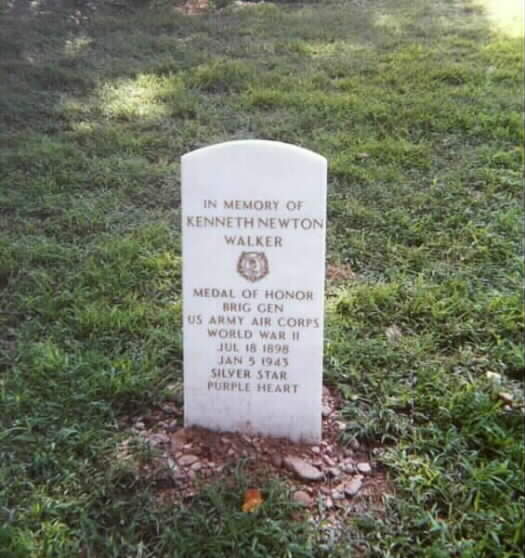
Courtesy of the United States Air Force Office of History:
Brigadier General Kenneth Newton Walker
Kenneth Walker enlisted at Denver, Colorado, December 15, 1917, and took his flying training at the University of California’s School of Military Aeronautics and Matther Field, California, getting his commission and wings in November 1918. For three years he was a flying instructor at Brooks and Barron Fields, Texas, and Fort Sill, Oklahoma.
In December 1922, as a First Lieutenant, he went to the Philippines as commander of the Air Intelligence Section at Camp Nichols. He held other duties there and returned to the United States in February 1925, as a member of the Air Service Board at Langley Field, Virginia. He stayed at Langley until 1928, having been Adjutant of the 59th Service Squadron, commander of the 11th Bomb Squadron, and Operations Officer for the 2nd Bomb Group. He graduated from the Air Corps Tactical School in June 1929, and stayed at Maxwell Field, Alabama, as an instructor of the school. He next attended the Command and General Staff School at Fort Leavenworth, Kansas, with graduation in June 1933, and promotion to Captain in August and to Major in October that year.
He went to Hamilton Field, California, where he served for three years as Intelligence and Operations Officer of the 7th Bomb Group, commander of the 9th Bomb Squadron and varied group duties. In February 1938, he went to Hawaii, serving as Operations Officer of the 5th Bomb Group at Luke Field, Arizona.; Executive Officer at Hickam, Hawaii and commander of the 18th Pursuit Group at Wheeler Field, Hawaii. General Walker returned to the United States in January 1941, as Assistant Chief of the Plans Division for the Chief of the Air Corps in Washington.
In July 1941, he was promoted to Lieutenant Colonel as the office became Headquarters Army Air Force. In March 1942, he was advanced to, Colonel and next month assigned to the Operations Division of the War Department General Staff.
In June 1942, he was promoted to Brigadier General and went to the Asiatic-Pacific Theater the next month, where he served from September 1942 to January 1943 as commanding general of the 5th Bomber Command. In this capacity he repeatedly accompanied his B-24 and B-25 units on bombing missions deep into enemy-held territory. Learning first-hand about combat conditions, he developed a highly efficient technique for bombing when opposed by enemy fighter planes and by anti-aircraft fire.
General Walker was killed in action January 5, 1943 while leading such a bombing mission over Rabaul, New Britain. He was awarded the Medal of Honor. Its citation, in part, reads “…In the face of extremely heavy anti aircraft fire and determined opposition by enemy fighters. General Walker led an effective daylight bombing attack against shipping in the harbor at Rabaul, which resulted in direct hits on nine enemy vessels. During this action his airplane was disabled and forced down by the attack of an overwhelming number of enemy fighters. He displayed conspicuous leadership above and beyond the call of duty involving personal valor and intrepidity at an extreme hazard to life.
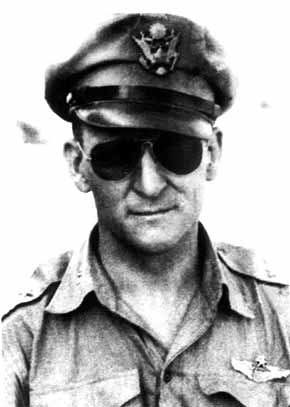
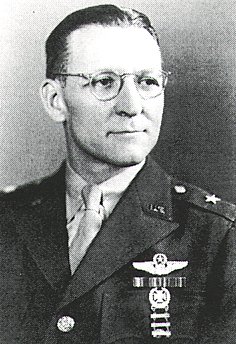
Courtesy of the Air Force Association: October 1990
By John L. Frisbee, Contributing Editor
Courage and Conviction
The skirmishes and battles that led to an independent Air Force were fought in Washington as well as in the field. Ken Walker was a hero in both arenas.
Kenneth Walker was a man of strongly held beliefs for which he was willing to risk his career or forfeit his life. His years as a military aviator were concerned with bombers and the Air Force doctrine of strategic air, warfare that dominated World War II.
Wlker earned his wings in November 1918. In the next decade he served with and commanded bomber squadrons in this country and the Philippines before attending the Air Corps Tactical School in 1928-29. The Tactical School was the intellectual center of the Air Corps in those days. Walker was kept on as an instructor in bombardment.
He and other airpower pioneers–among them Donald Wilson, Harold George, Haywood “Possum” Hansell, and Laurence Kuter–developed analytical systems for determining the key elements that sustained an industrial society and that were vulnerable to bombing. They concluded that a new era of warfare, in which an industrial country could be defeated primarily by strategic bombing, lay just over the horizon. It followed that a nation’s air arm should be independent and co-equal with ground and sea forces. These ideas were heresy in the eyes of the War Department General Staff, which did not burn heretics but could make life unpleasant for them.
In 1934, Walker and four other Tactical School pioneers were invited to testify before the President’s Commission on Federal Aviation (the Howell Commission) on the military aspects of aviation. The War Department tried by both direct and devious means to prevent their appearance in Washington, but the five officers decided to go at their own expense, though it probably would mean the end of their careers. World developments determined otherwise. All five became general officers, and their concept of airpower was proven correct.
On the eve of World War II, Walker, by then a Lieutenant Colonel, was assigned to the War Plans Division of the Army Air Forces staff.
Under the direction of George, Hansell, Kuter, and Walker formed the task force that wrote AWPD-1, the plan for organizing, equipping, deploying, and employing the AAF to defeat Germany and Japan should we become involved in the war that was engulfing Europe and the Far East. lt was a monumental achievement, completed in less than a month. Then Japan attacked Pearl Harbor and the US was, in fact, at war.
Walker had missed World War I. He did not intend to sit out World War II in Washington. Six months after Pearl Harbor, he was promoted to Brigadier General and went to the Pacific, where General George Kenney made him commander of the Fifth Air Force Bomber Command. Walker had precious little to work with in the fall of 1942–some 30 operational B-17s and about a hundred light and medium bombers.
Walker championed leadership by example as ardently as he was devoted to bombardment. He believed he should share the dangers of combat with his crews. Perhaps more important to him, Walker judged that he could not help develop tactics for that theater without personal experience in combat.
Early on, he was awarded the Silver Star He went several times to Rabaul, the hottest target in the theater. He came back from one mission with six feet of wing missing and from others with battle damage. Kenney worried about his bomber commander, who was privy to much highly classified information, flying over enemy-held territory In December, he ordered Walker to fly no more combat missions.
On January 5, 1943, contrary to Kenney’s order, Walker led 12 heavy bombers in a daylight attack on shipping in the harbor at Rabaul. The formation was intercepted by enemy fighters but put its bombs on target. One bomber was shot down. Walker’s plane was last seen leaving the target with one engine burning and enemy fighters on its tail. A search failed to find any wreckage or survivors.
On the recommendations of Generals MacArthur and Kenney, Brigadier General Kenneth Walker was awarded the Medal of Honor posthumously. President Roosevelt presented the medal to Walker’s son in a White House ceremony on March 25, 1943. The Air Force had lost one of its most brilliant officers, who lived with the conviction that bombardment had changed the nature of warfare and that a “well-planned and well-conducted bombardment attack … cannot be stopped.”
WALKER, KENNETH NEWTON
BRIG GEN US ARMY AIR CORPS
VETERAN SERVICE DATES: 12/15/1917 – 01/05/1943
DATE OF BIRTH: 07/18/1898
LOST IN ACTION: 01/05/1943
DATE OF INTERMENT: 01/05/1943
STATUS: MISSING IN ACTION
BURIED AT: SECTION MC SITE 36-M (Memorial Section – Gravestone Only)
Michael Robert Patterson was born in Arlington and is the son of a former officer of the US Army. So it was no wonder that sooner or later his interests drew him to American history and especially to American military history. Many of his articles can be found on renowned portals like the New York Times, Washingtonpost or Wikipedia.
Reviewed by: Michael Howard

